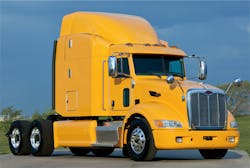Event seeks to mobilize move to natural gas
FT. WORTH, TX. At a special customer event organized by Peterbilt Motors Co. here at the Texas Motor Speedway, fleets and dealers were provided with an opportunity to investigate a variety of natural gas-powered truck models along with refueling strategies and return on investment (ROI) to establish the economics of switching over to this alternative fuel in the face of rising diesel costs.
“We all agree that natural gas doesn’t fit everyone – but it does fit a majority of the trucking applications in the U.S.,” said Greg Young, director of OEM and business development for Cummins Westport Innovations (CWI) during the event’s first day. “It’s not the right answer for everyone, but it does mitigate the risk of diesel volatility.”
David Jaskolski, senior account manager with Southeast LNG, said the “sweet spot” for natural gas is in what he calls “hot seat” trucking operations, where vehicles operate continuously across multiple shifts of drivers running in centrally-fueled, hub-and-spoke or regional route operations. “That’s where natural gas shines,” he noted.
Peterbilt hosted more than double the number of customers and dealers at its Natural Gas Leadership 2012 meeting compared its typical customer events, noted Robert Woodall, the company’s director of sales and marketing, with some 180 customers and dealers in attendance.
He added that Peterbilt is investing millions to widen its natural gas-powered truck offerings, with plans to build 2,000 trucks powered by either compressed (CNG) or liquefied (LNG) natural gas by the end of this year. He also said the company expects that by the end of 2012, 100% of the natural gas trucks it builds will have factory-installed fuel systems.
“Our parent company Paccar has invested $2 billion over the past two years in new products, facilities, and technology – and that includes alternative fuel technology,” he said. “That’s part of our overall effort to drive the cost of operations down for our customers.”
Kelly Mills, western U.S. territory manager for Westport Innovations, noted that current estimates indicate that the U.S. has a 100-year supply of natural gas – with much of it aligned underground along most of the heavy truck travel corridors across the country. “That means the ‘well-to-wheel’ emissions reductions are that much greater; some 26% to 27% less when compared to oil,” he noted.
Shaunt Hartounian, regional manager for national accounts at Clean Energy Fuels, believes fleets should become early adopters of natural gas in order to reap the maximum benefits of the fuel – and not just because, at the moment, it costs $1 to $1.50 per gallon less than diesel.
“Fleets that have switched to natural gas are figuring out how to take freight contracts away from established players – because they are greener yet offer a lower cost as well,” he pointed out. “They are using all the tools in the tool box to compete more effectively for freight.”
About the Author
Sean Kilcarr
Editor in Chief
Sean Kilcarr is a former longtime FleetOwner senior editor who wrote for the publication from 2000 to 2018. He served as editor-in-chief from 2017 to 2018.
